Increasing Battles at Prodigy
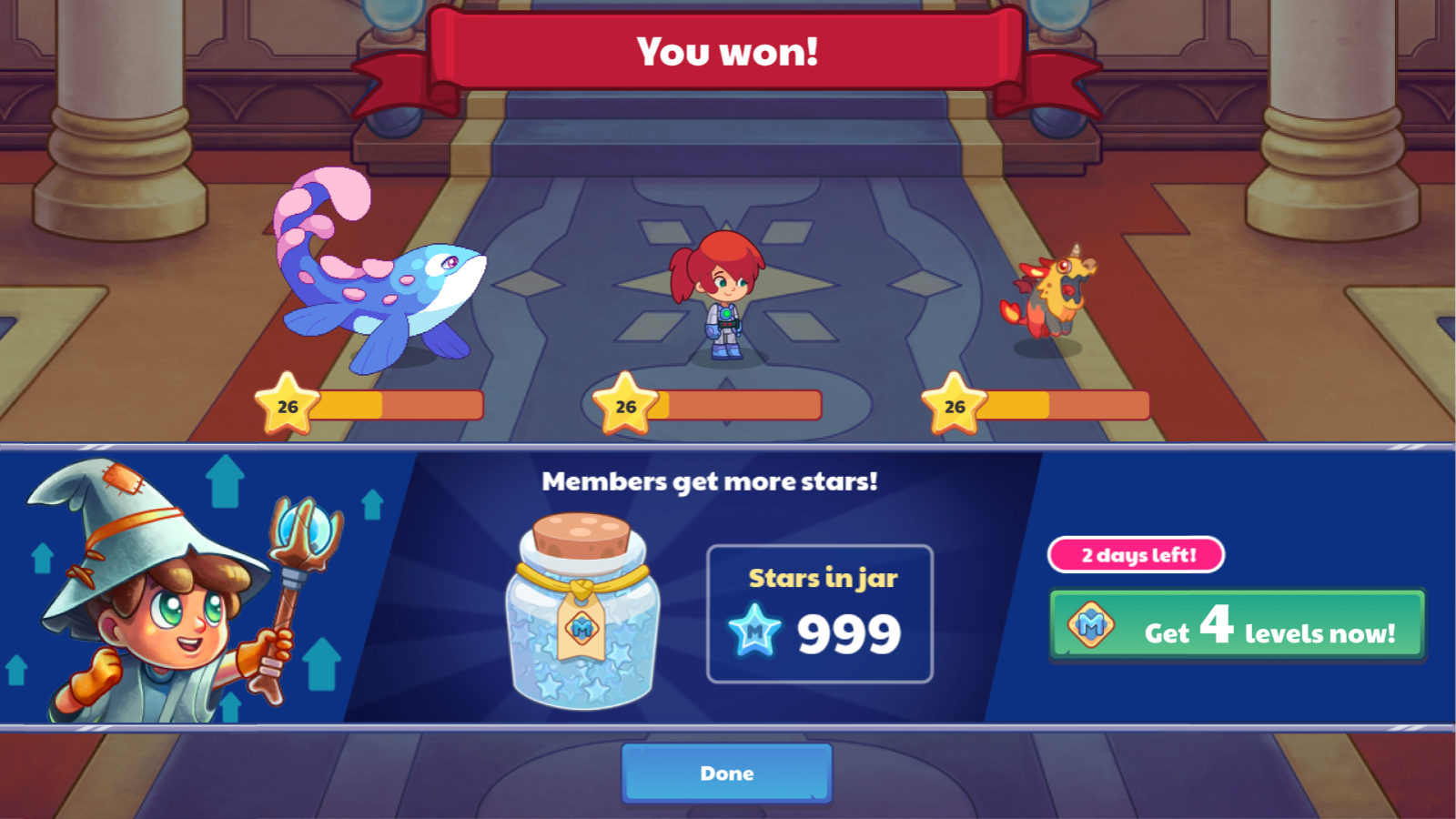
During my time with Prodigy as a Product Manager, my responsibilities included the Upgrade corner of the game loop (Explore, Battle, Upgrade), all live operations, all in-game player communications (in collaboration with marketing), and in-game membership prompts (ads for kids). While I had several wins with membership prompts, live operations, and player communications, this is the story of increasing battles while balancing the game economy.
PRODIGY IS A MATH GAME FOR KIDS. MORE BATTLES MEANS MORE MATH QUESTIONS ANSWERED WHICH RESULTS IN STRONGER MATH SKILLS.
Prodigy Business Context
Play at School
Prodigy can't compare with Fortnite head on. Our unfair advantage was that teachers encouraged use at school.
Short Sessions
Because teachers largely controlled play time, the average session length was roughly 15 minutes.
Grades 1-3
While supporting grades 1-8, and targeting grades 1-5, our highest engagement was with the younger grades.
Identified Problems
Through customer service feedback and data analysis, we identified two critical issues that were limiting player engagement and disrupting the game economy.
"The post battle flow takes a long time and is frustrating users"— CS and user feedback
"Players have enough currency to buy everything, which makes currency valueless"— Data analysis
Game Upgrade Strategy
To address these problems, we developed a two-pronged strategy that would both improve the user experience and balance the game economy.
Make Space
Reduce the post battle flow time in order to increase the % of time the player can explore, battle, and upgrade.
Upgrades!
Enable players to upgrade pets and gear, acting as a sink for currencies (helping balance the economy) while encouraging battles.
Post Battle Flow Analysis
The post battle flow is a critical moment in the player journey—it's where victory is celebrated, progress is communicated, and Prodigy's value is reinforced. However, our analysis revealed that this experience was creating significant friction that was limiting player engagement.
We thoroughly mapped out the existing process step-by-step to identify specific opportunities for improvement and understand exactly where time was being lost in the user experience.
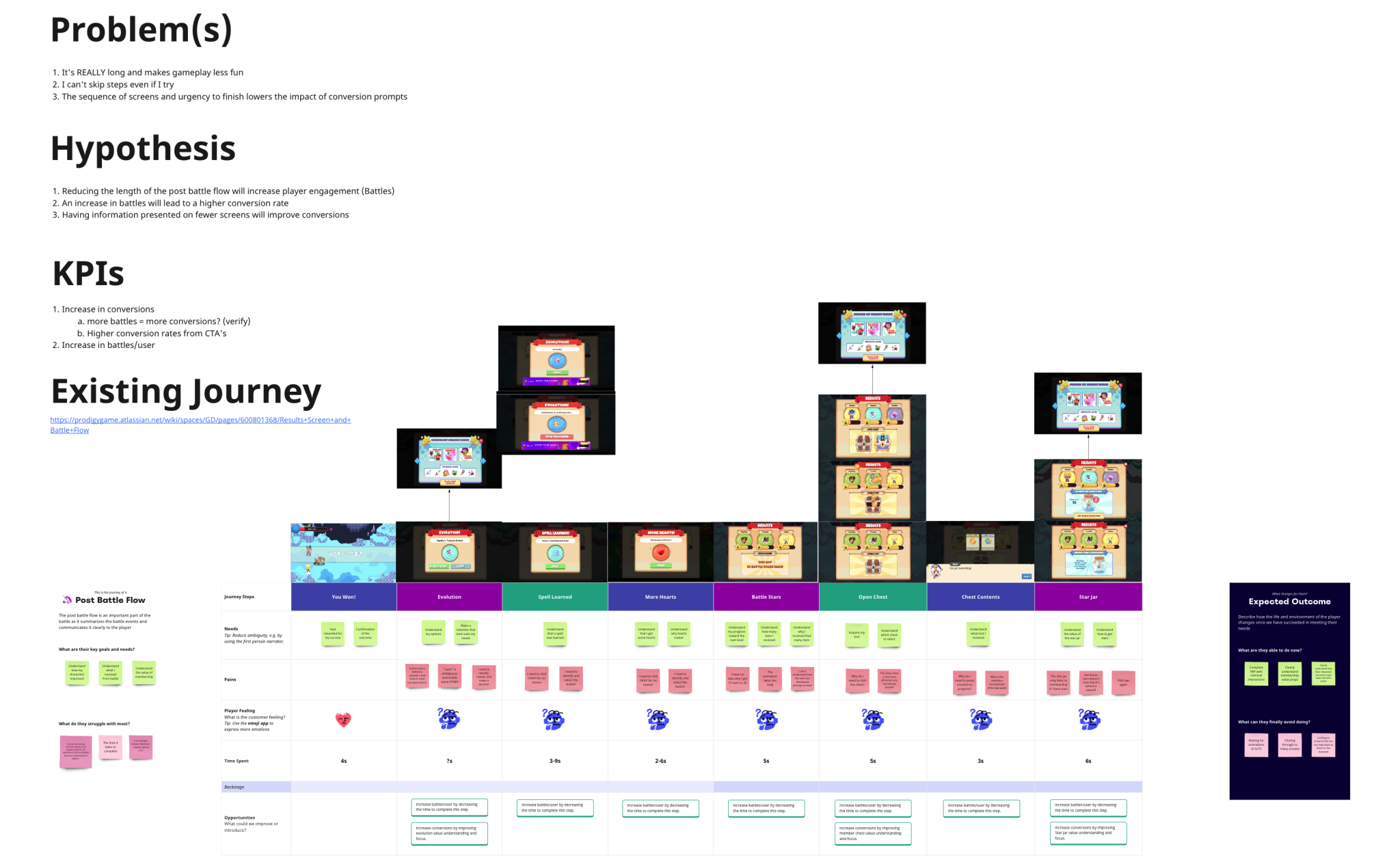

We conducted an in-depth review of comparable game systems and post battle flows across the industry to understand best practices and identify opportunities for optimization in our own implementation.
Our Hypothesis
REDUCING THE LENGTH OF THE POST BATTLE FLOW WILL FREE UP PLAYER TIME TO BATTLE MORE OFTEN
To validate this hypothesis, we conducted an in-depth analysis across six key areas that revealed critical insights about the user experience and solution requirements.
User Needs
Players need to understand the value gained through battle, recognize membership benefits, and feel properly rewarded for their success. Each step must serve these core needs.
Pain Points
Manual button clicking where auto-progression would be appropriate, and inconsistent button placement that violates Fitts' Law, creating unnecessary friction in the flow.
Emotional Journey
Initial delight from winning quickly turns to frustration as players navigate through multiple required screens before returning to gameplay.
Time Investment
Each screen took 3-5 seconds, adding up to significant time investment. We implemented tracking to ensure accurate measurement of improvements.
Celebration & Achievement
Every battle completion is an opportunity to celebrate player success, showcase earned rewards, and reinforce the sense of accomplishment that drives continued engagement.
Value Communication
Strategic placement of membership benefits and premium features within this flow helps demonstrate Prodigy's value proposition at moments when players are most receptive.
After an in-depth discovery process and analysis of other games, the team arrived at an elegant solution that was much faster and easier to navigate, resulting in a 42% reduction in flow time while maintaining the essential elements of celebration and value communication.
Based on our analysis and research, we designed an optimized post battle flow that streamlines the experience while preserving the essential elements of celebration and value communication.

Although less impactful than expected, we were able to significantly increase battles/WAU with a 43% decrease in post battle time. Without any obvious iterations I refocused the team toward upgrade.
Pet Upgrade System
With the post battle flow optimized, we turned our attention to the second pillar of our strategy: creating meaningful upgrade opportunities that would balance the economy while driving player engagement.
The Problem
Pets are the most exciting element of the game, but players can only keep them at wizard level by actively playing with them. Any neglected pet falls behind, requiring more work to catch up.
The Opportunity
Allowing players to spend gold to upgrade pets would balance the economy while driving battles, as upgraded pets create excitement and encourage players to test their new strength.
Our Hypothesis
ALLOWING PLAYERS TO SPEND GOLD TO UPGRADE PETS WILL HELP BALANCE THE ECONOMY WHILE DRIVING BATTLES
I created a comprehensive user flow to outline the player journey and collaborated with product designers to refine the experience. The system would indicate upgradeable pets with a green glow and provide clear upgrade options within the pet information screen.

User Journey
Players can access the upgrade system through multiple paths: via the Mythic Badge tab or directly through pet icons, ensuring intuitive discovery and access.
Visual Feedback
Upgradeable pets are clearly indicated with a green glow, making it easy for players to identify which pets can be enhanced and take action.
This pet upgrade system would serve as both an economic sink for excess gold and a powerful motivator for continued gameplay, as players would be excited to test their newly upgraded pets in battle.
Awareness
To drive awareness of the pet upgrade feature, a notification was added to the HUD that directs players to the pets screen. While the HUD typically routes players to the Mythics tab for conversion purposes, this implementation prioritizes user experience by taking players directly to the pets screen.
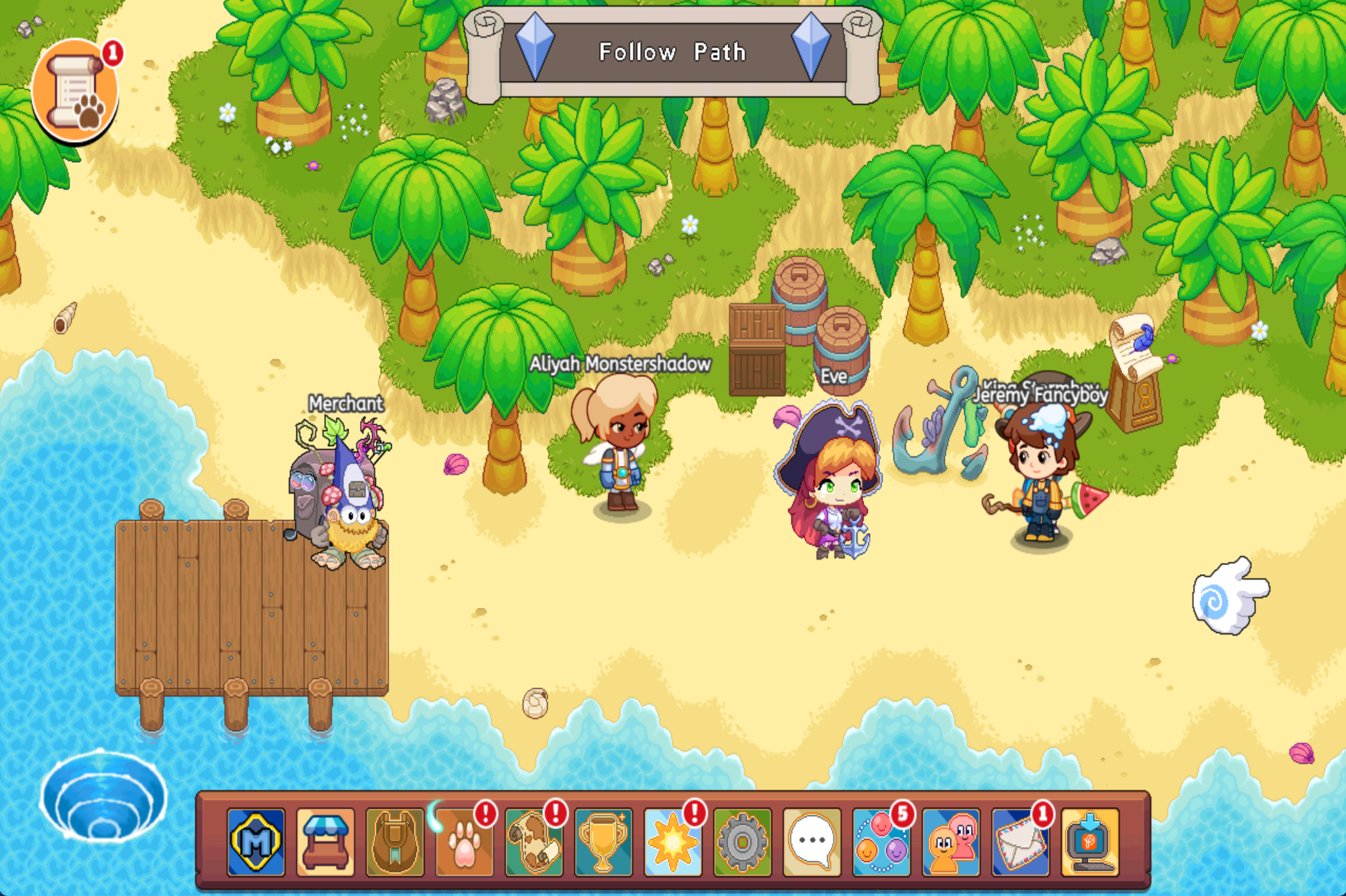
Pet Inventory
When players tap the HUD pet icon, they arrive at their pet inventory where a prompt guides them to the first available pet for upgrade. All upgradeable pets are clearly indicated with a blue up arrow, making it easy to identify which pets can be enhanced and take action.
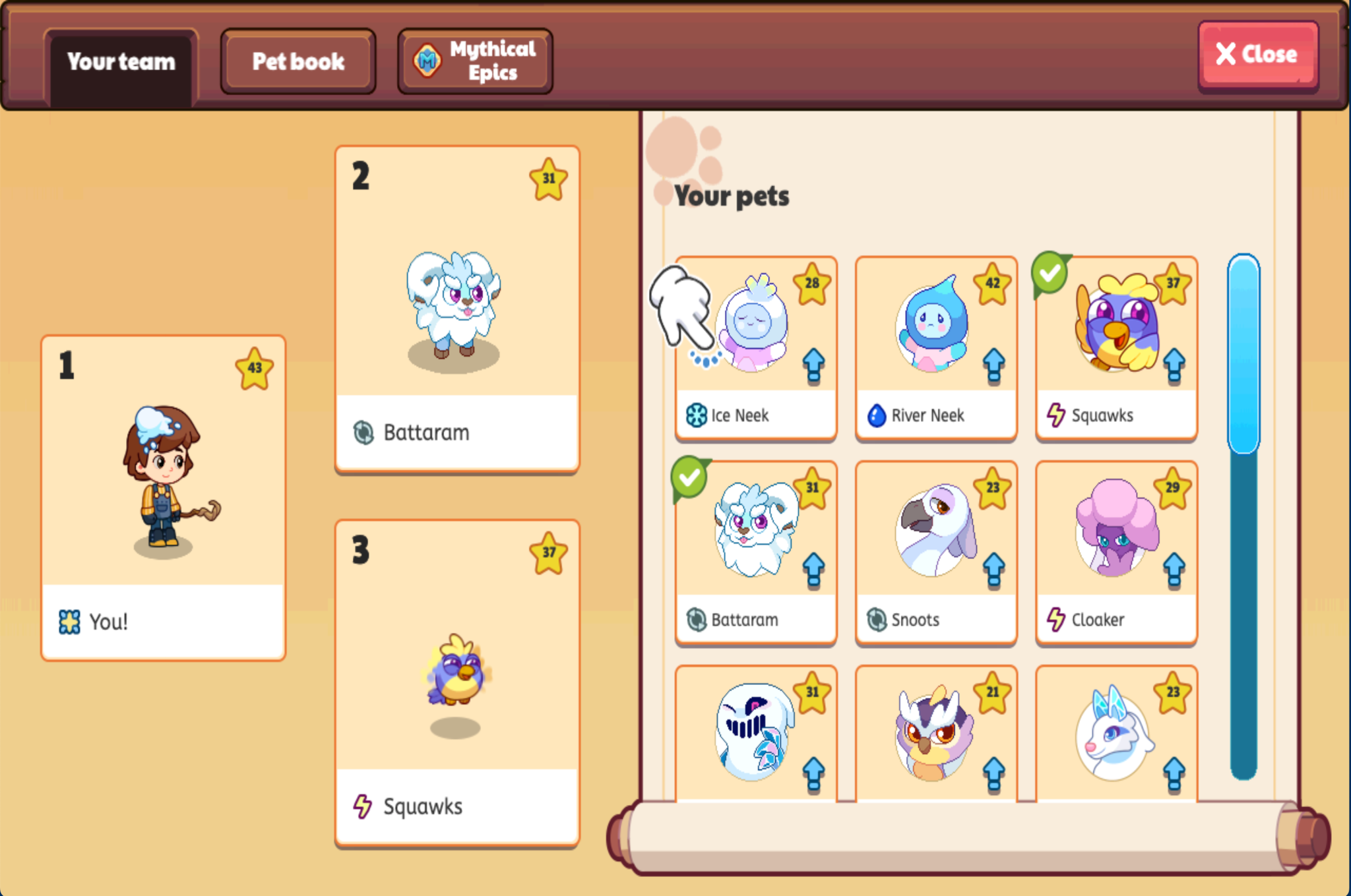
Upgrading a Pet
Players can spend gold to upgrade their pet to match their wizard level, unlocking their full potential in battle. The upgrade cost is clearly displayed before the transaction, ensuring transparency and informed decision-making. We included a pretty fancy animation for the pets leveling up to create delight and celebrate the player's investment.
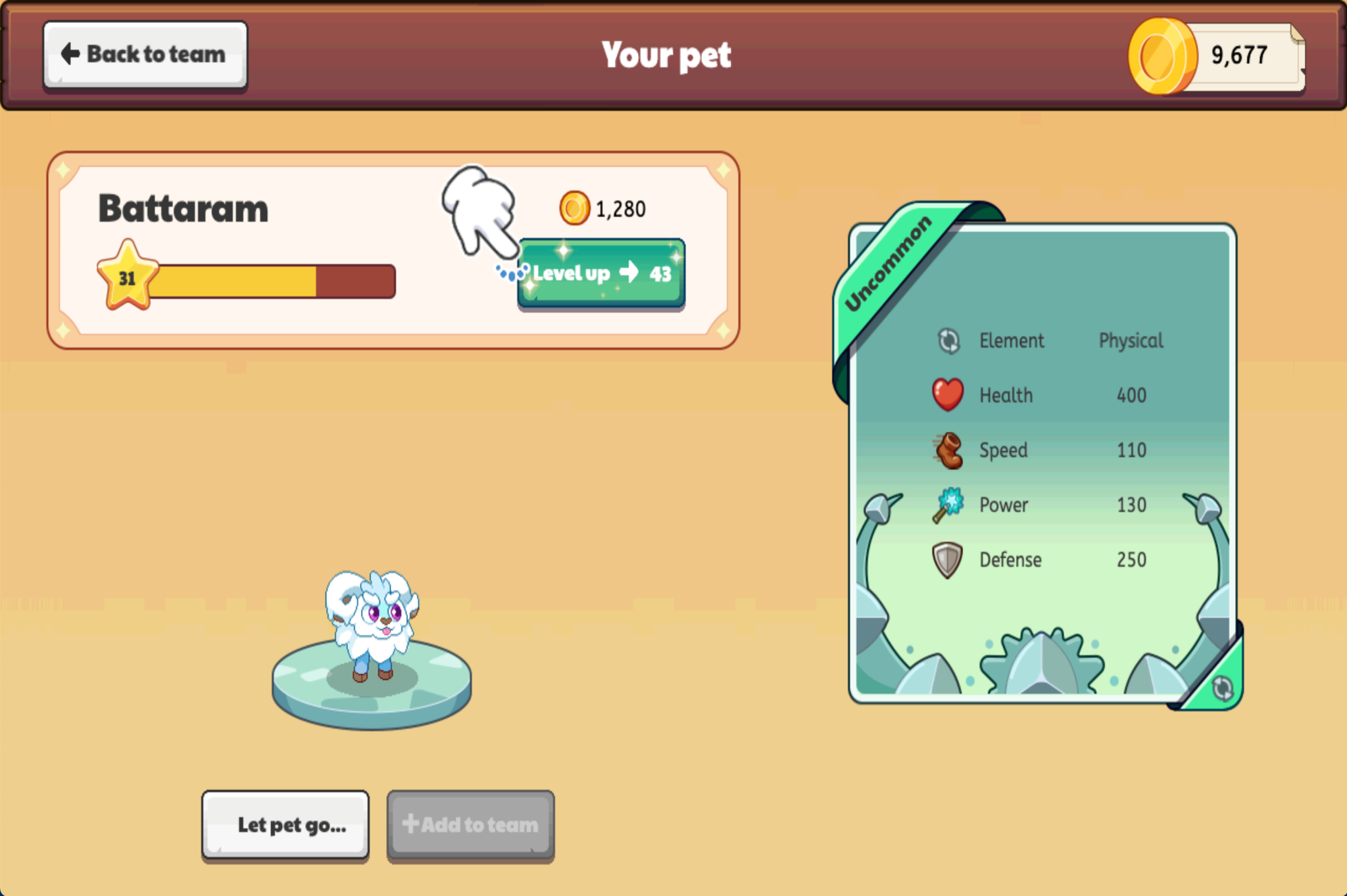
Learnings
The pet upgrade feature was a huge win for players and the business. It delivered significant increases in battles and conversions, played a crucial role in balancing the economy by draining a significant percentage of gold currency, and achieved a notable increase in session length—a metric that's very difficult to move given the dependence on teachers.
Gear Stats System
Building on the success of the pet upgrade system, we turned our attention to gear—the second most desirable element in Prodigy. Previously, gear was purely cosmetic, effectively turning the game into a dress-up experience. Our goal was to make gear matter in battles, transforming it into a meaningful part of the core game loop.
The Problem
Gear was purely cosmetic, making Prodigy feel like a dress-up game rather than a strategic battle experience. Players had no incentive to purchase or engage with gear beyond aesthetics.
The Opportunity
Making gear functional in battles would create meaningful progression, encourage purchases, and drive more engagement with the core battle mechanics.
Our Hypothesis
HAVING RARER GEAR BE STRONGER IN BATTLE WILL ENCOURAGE PLAYERS TO PURCHASE GEAR AND BATTLE MORE
A comprehensive game analysis was conducted to rebalance gear pricing and availability. The design led players through the game in a way that always positioned the next gear unlock ahead of them, creating a powerful sense of progression and purpose.
Strategic Progression
The system was designed to always have the next gear unlock visible ahead, creating a clear progression path that motivates continued gameplay.
Battle Integration
Rarer gear provides stronger battle performance, making gear selection a strategic decision that impacts gameplay outcomes.
This gear stats system transformed gear from purely cosmetic items into meaningful strategic choices that enhance both the battle experience and the progression loop.
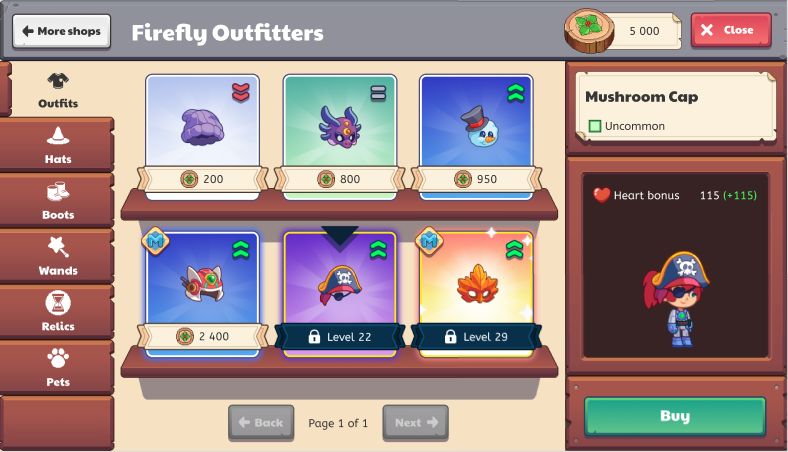
Implementation & Learnings
To accomplish this goal, we first needed to educate players on the strength of their gear relative to what was available. We introduced intuitive icons to represent stronger, weaker, and same strength gear, helping players understand their current position and make informed decisions.
While we expect this to be a significant gameplay win long-term, the initial gear stats release was not able to measure immediate game impacts. There are several follow-up hypotheses to make gear matter more meaningfully, and the team continues to work on providing players with compelling ways to spend their hard-earned rewards.
Summary
During my time with Prodigy, I successfully increased battles by creating more space for gameplay through the optimization of the post battle flow. I was able to significantly strengthen the upgrade corner of the game loop by enabling players to upgrade their pets and taking initial steps toward making gear matter in meaningful ways.
Post Battle Flow
Reduced flow time by 43% while maintaining essential celebration and value communication elements, freeing up more time for players to engage in battles and upgrades.
Pet Upgrade System
Created a comprehensive upgrade system that balanced the economy, increased battles and conversions, and significantly improved session length—a notoriously difficult metric to move.
Gear Stats System
Transformed gear from purely cosmetic items into meaningful strategic choices that enhance both the battle experience and the progression loop, with clear long-term potential.
Strategic Impact
Established a foundation for sustainable game economy balance and player engagement through systematic analysis, user-centered design, and data-driven optimization.
These initiatives collectively strengthened Prodigy's core gameplay loop, creating more engaging experiences for players while building a more balanced and sustainable game economy.